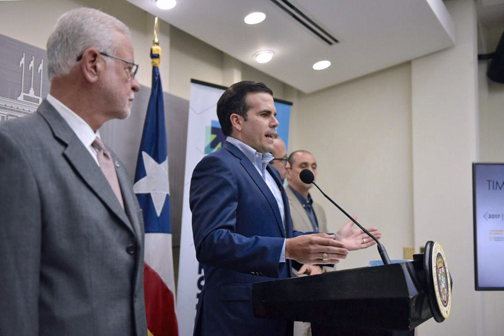Rosselló unveils ‘preventive preparation’ plans for next hurricane season


Gov. Rosselló, center, unveils plans to address future emergencies.
Puerto Rico Gov. Ricardo Rosselló, presented a plan to review protocols and develop initiatives for preventive preparation for the next hurricane season after experiencing Hurricane María on the island.
Six months after the most catastrophic hurricane in Puerto Rico’s modern history, Rosselló stressed the emergency caused by the passage of María made clear once again the unequal treatment of the island in comparison with other jurisdictions of the United States.
“After analyzing the successes and setbacks experienced as part of the emergency in the face of the passage of hurricanes Irma and María, our government is reviewing all protocols and processes to make sure we are ready for a new hurricane season. This work, which has wide-ranging challenges, goes hand-in-hand with the process of rebuilding the island,” the governor said, adding a summit of central government agencies and the Federal Emergency Management Agency is slated for May 29.
Meanwhile, a municipal emergency summit will be held May 30.
The governor also explained that his administration will establish what will be known as the “Rainy Day Fund,” to have the money needed to ensure the immediate arrival of help brigades during an emergency.
Rosselló recalled the establishment of the Puerto Rico Central Office of Recovery, Reconstruction, and Resilience (COR3), which will implement the centralized supervision and financial controls that the government of Puerto Rico and the federal government will have for the recovery process.
This office will also guarantee that the government can implement reconstruction efforts with efficiency and transparency; as well as capitalize on the opportunities to “achieve a reconstruction for a better, stronger and more resilient Puerto Rico.”
The executive director of COR3, Omar Marrero, said “the commitment of this administration with Congress is to carry out the recovery process with the transparency, efficiency, and responsibility that these times demand.”
Adoption of new disaster relief guidelines
To achieve greater efficiency and transparency, the guidelines of the National Disaster Recovery Framework were adopted, which suggest that the recovery process be structured by means of 10 sectors. Nonetheless, the magnitude of the emergency — and therefore the complexity of the recovery processes — required two additional sectors: municipalities and education.
In addition to having a centralized structure, internal and external necessary resources are also being identified to achieve execution.
As part of this, a process of request for proposals was initiated, in which the best consultants — the most skilled and experienced in these recovery processes — were sought, he said.
They will be the collaborators in the development of strategic and compliance services; in the formulation of projects; in the review of grant application processes; and in data management.
Marrero said the process was carried out and that the selected companies were Deloitte, ICF, and CGI.
“Today we give an update, a summary of the work done by the recovery office, COR3, since the arrival of the hurricanes Irma and María that impacted the island in September 2017,” Marrero said.
The governor signed the Executive Order to create the COR3 in October 2017.
In November, the petition known as “Build Back Better” was made to the U.S. Congress, as a formal request to Washington to provide the island with federal grant programs for long-term recovery, with the intention of rebuilding a stronger and more resilient Puerto Rico.
In December, the Board of Directors of the Puerto Rico Public-Private Partnerships Authority approved the COR3 office and began the process of request for proposals, which took place between December 2017 and January 2018.
In February, the consultants were selected and, in turn, the governor authorized representative (GAR) moved to the COR3.
“We hope that within the next 30 days we can disclose to the public what the guidelines for the Hazard Mitigation Grant Program will be, from which all the municipalities of Puerto Rico will benefit,” Marrero said.












